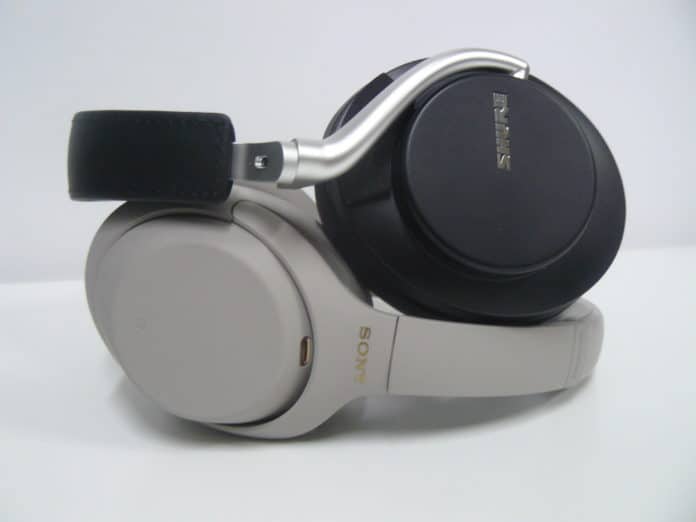Its time to revisit the Sony vs Shure battle for brand superiority. This godforsaken year has brought us two of the leading innovators in wireless over-ear headphones delivering new cans for us to listen to. Those are the Shure AONIC 50, and the Sony WH-1000xM4. I recently got to review the XM4 for MajorHiFi, and the Aonic has been out for quite some time. I’ve seen a lot of comparisons between Sony’s previous iteration of the XM4 and the Aonic, but I wanted to get my piece out there for their latest release. I’m here now to give you a comparison between the Sony WH-1000xM4 and the Shure AONIC 50 and give you some insight on which headphone is the wiser purchase.
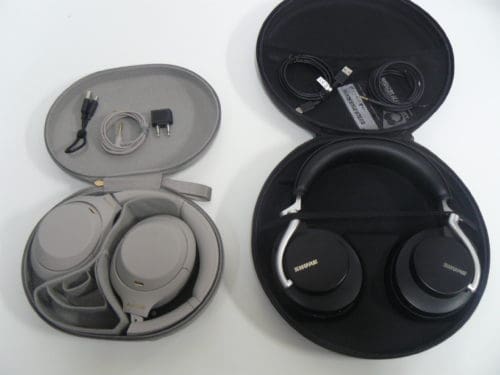
What You Get
Packaging contents for both the XM4 and the Aonic 50 are limited, as the main draw of the wireless experience is not having to deal with too many accessories. Each headphone comes with a USB Type C charging cable, 3.5mm headphone jack, and a portable carrying case. The XM4 does include an airplane adapter, which isn’t a huge deal, but it’s a plus for the people that are looking for it. In comparing the portability of cases, I thought the XM4 was more compact, being that the headphones themselves fold in nicely. The Aonic 50 doesn’t have that novelty, Instead, the earcups turn over so the headphones lay flat in the case. I think the case itself is more durable than the XM4, but Sony’s are easier to pack and carry around.

Look and Feel
Both models have a sharp look to them, but the Aonic 50 sports a more “real deal” look, as the build quality just seems to be at a higher standard than the XM4. To me, the XM4 looks too much like a toy, with its plastic shell makeup. The 1000x line also hasn’t changed a whole lot since its first iteration, so the design has remained compact, but uninspired. In terms of fit, both cans feel just fine. The foam pads on the Aonic were a bit more fluffy than the XM4 and seemed a little less cheap. The Aonic 50 does apply some more pressure on your head compared to the XM4, but Shure’s sports a more secure fit.

Design and Functionality
When it comes to what’s going on under the hood, the Aonic 50 has a bit more of an edge. Shure implements a 50mm driver instead of Sony’s 40mm driver that the XM4 has kept for it’s past few models. Both drivers implement a neodymium magnet, but the XM4 boasts a much wider frequency response at 4Hz-40kHz, while the Aonic sits at 20Hz-22kHz. What effect this has on signature we’ll touch on later.
Then there’s the interface design. How well these headphones respond to specific gestures is a key point when talking about any wireless, noise-canceling headphone. I felt that with the XM4 the touch surface gestures were mostly responsive, but certain playback controls had a noticeable delay and were a little finicky at times. Enough times to be a problem. The Aonic 50 is simple in its functionality. The only interactions you’ll have with the Aoinc 50 are the row of buttons to control most of the headphone’s controls. The Aoinc has fully responsive buttons dedicated to play/pause, volume, power, and Bluetooth pairing. Noise-canceling is controlled by a switch, with the effect being immediate. The touch gestures on the XM4 are nice and innovative in trying to enact a more hands-free experience, but the tech isn’t quite there yet.
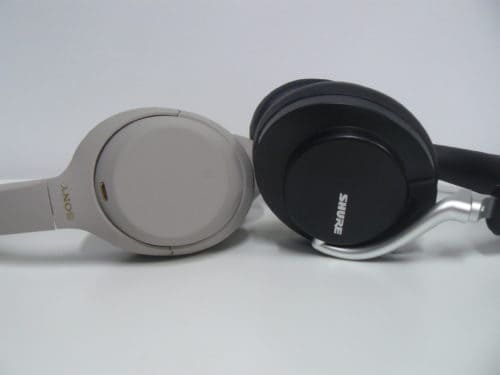
Features
In terms of features though, the XM4 just offers so much more variety. In my review for the 1000x m4 here on Major HiFi, I mentioned the new DSEE(Digital Sound Enhancement Engine) system, which aims to enhance your tracks in real-time. The goal is to have lossy sound like lossless, which is a great concept, I just hope future models improve on this feature because for now it rarely has any noticeable effect on tracks. Sony’s Ambient and adaptive sound control have been great carry-overs from their last model, as well as 360 audio if you’re able to access it. Shure doesn’t really have any extra features to counter this besides their own, less effective environmental controls. Both headphones do enact excellent, industry-leading noise-canceling though, but Sony has a leg up over the Aonic 50 with its dual noise sensor, which captures even more ambient noise.
An important aspect of both these headphones worth pointing out is that they offer their own companion apps. The XM4 uses Sony’s Headphone Connect app, while the Aonic uses ShurePlus Play. Both these apps have access to most of the headphone’s controls, as well as EQ. However, I found that Shure’s app had a better design, and was more user friendly.
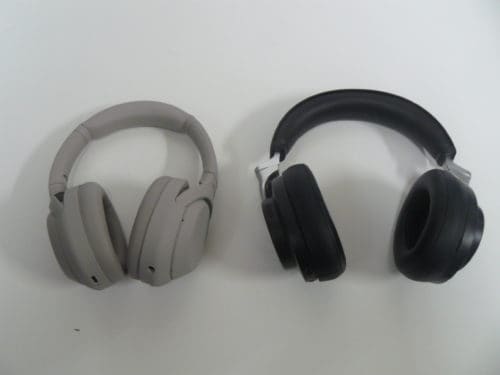
Battery Life
The XM4 takes a big lead here, offering 30 hours of battery life, while the Aoinc 50 only offers 20. There’s even more of a difference when considering the XM4 can run up to 8 hours longer than that without noise-canceling enabled.
Bluetooth
Both headphones integrate a multi-point system, which lets you connect to two devices at the same time. They offer Bluetooth 5.0 for high bandwidth connections, but the Aonic 50 offers more CODECs than the XM4 in aptX, aptX HD, and aptX low latency.
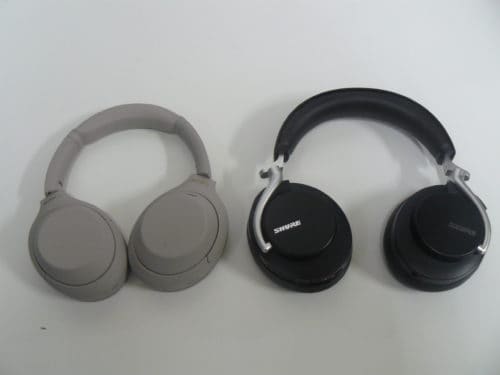
Soundstage
The XM series has never been one for highly accurate image production, and the XM4 didn’t do much differently. The stage is mostly tight and boxy, but has good resonance, even if the clarity becomes unfocused in return. The Aonic 50 is one of the best stages you’re going to get in a wireless headphone. The amount of width and depth on the Aoinc 50 is impressive, and specific tracks have the potential to sound very large and dignified. The track “The Moons at Your Door” by Current 93 is this Lynchian soundscape of winds, and ominous steps that makes great use of stereo imaging. On the Aoinc, the track weaves through you in a semi-linear pattern, but some sounds approach you in a threatening way that these headphones make good use of.
Low End
There couldn’t be more of a difference when it comes to the bass responses of both these cans. The XM series has been known to have a satisfying bass, but I always found it to be a little muddy, especially around the lower mids. They do have a grander, resonance than the Aonic, but the Aonic’s bass is just so buttery smooth, and way more ideal for me. It isn’t very deep, or impactful, but it’s balanced well and responds well to EQ boosts if you’d prefer that.
Mids
The biggest difference here is clarity. The XM4 can be muffled at times, instruments don’t sound as clear as they could, like in the Aonic. The Aonic’s mids aren’t even that notable, they’re just far more balanced and flat. It likens more to what the mid-range of a studio headphone might look like, which makes sense coming from Shure.
Highs
The highs on the XM4 are very tightly controlled, and the noise-canceling really brings that out. With the Aoincs, just a little bit of extension goes a long way, as the headphones include just enough highs to add some significant top end to the signature. You get just enough sparkle and shine to make you happy, and female vocals will sound especially crisp.
Summary
I think I’ve made it pretty clear where I lean in this debate. This is only Shure’s first noise-canceling headphone, and they came out swinging. The XM series has some incredible technology behind it, and some that are way more practical than what’s offered on the Aonic 50. However, when it comes to sound quality there isn’t anywhere else to look, the Aonic 50 just runs away with it.
Spec Comparison
| Shure Aonic 50 | Sony WH-1000XM4 | |
| Driver | 50mm | 40mm |
| Frequency Response | 20Hz-22kHz | 4Hz-40kHz |
| Battery Life | 20hrs | 30hrs |
| CODECs | aptX,aptX HD, aptxLL, SBC, LDAC, AAC | SBC, LDAC, AAC |
| Bluetooth | 5.0 | 5.0 |
The Sony WH-1000XM4 is available at Auido 46
Shure Aonic 50 is also available at Audio 46
MAJORHIFI may get a commission from retail offers.
MAJORHIFI may receive commissions from retail offers.


